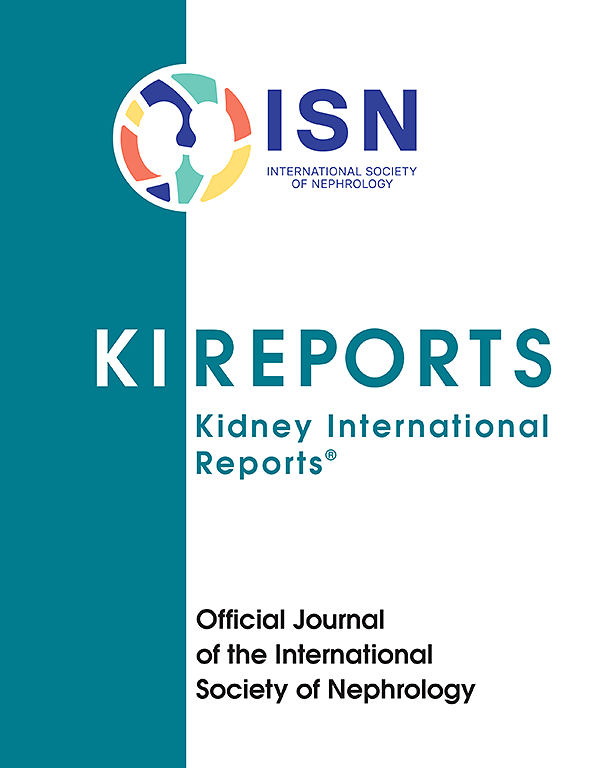Extrarenal Clinical Features are Reported for Most Genes Implicated in Genetic Kidney Disease
IF 5.7
2区 医学
Q1 UROLOGY & NEPHROLOGY
引用次数: 0
Abstract
Introduction
Genetic kidney disease is often suspected based on a family history of the disease or the presence of extrarenal features. This study examined how often a positive family history or syndromic features are found.
Methods
A total of 255 genes from the Genomics England “green” lists for congenital anomalies of the kidney and urinary tract (CAKUT) (n = 57), ciliopathies and cystic kidney diseases (n = 90), hematuria (n = 5), renal proteinuria (n = 55), and renal tubulopathies (n = 48) were examined for mode of inheritance and, in the Online Mendelian Inheritance in Man (OMIM), for reported clinical features in different systems (neurological, cardiac, etc.) that would be obvious on a history or physical examination.
Results
Autosomal recessive (AR) inheritance was recorded for 148 of the 248 genes (60%) with an OMIM entry. Extrarenal features were associated with 221 genes (89%), including those causing hematuria (5, 100%), renal ciliopathies (86, 97%), CAKUT (52, 91%), renal tubulopathies (41, 85%), and proteinuric renal diseases (37, 76%).The median number of affected systems was 4 (range: 0–10). More extrarenal features were associated with CAKUT (4, 0–10) and the ciliopathies (5, 0–9) than with hematuria (2, 2–5), proteinuria (3, 0–7), and the tubulopathies (3, 0–7) (P < 0.00001). The most commonly-affected systems were growth and musculoskeletal (164, 66%), neurological (147, 59%), and ocular (133, 54%).
Conclusion
Extrarenal associations have been reported for most genes affected in genetic kidney disease, and are more common with pediatric-onset conditions with recessive inheritance. However, information is limited for how often extrarenal features are found in any individual.

大多数与遗传性肾病相关的基因的肾外临床特征被报道
遗传性肾脏疾病常被怀疑是基于疾病的家族史或存在肾外特征。这项研究调查了发现阳性家族史或综合征特征的频率。方法从英国基因组学“绿色”列表中,共检测了255个基因,用于先天性肾和尿路异常(CAKUT) (n = 57)、纤毛病和囊性肾病(n = 90)、血尿(n = 5)、肾蛋白尿(n = 55)和肾小管病(n = 48)的遗传模式,并在人类在线孟德尔遗传(OMIM)中检测了不同系统(神经系统、心脏、等),这在病史或体检中很明显。结果248个基因中有148个(60%)存在常染色体隐性遗传。肾外特征与221个基因(89%)相关,包括引起血尿(5.100%)、肾纤毛病(86.97%)、CAKUT(52.91%)、肾小管病(41.85%)和蛋白尿肾病(37.76%)的基因。受影响系统的中位数为4(范围:0-10)。与血尿(2,2 - 5)、蛋白尿(3,0 - 7)和小管病变(3,0 - 7)相比,与CAKUT(4,0 - 10)和纤毛病(5,0 - 9)相关的肾外特征更多(P <;0.00001)。最常受影响的系统是生长和肌肉骨骼(164,66%),神经系统(147,59%)和眼部(133,54%)。结论大多数遗传性肾病的基因均与肾外相关,且在隐性遗传的儿科发病疾病中更为常见。然而,对于在任何个体中发现外部特征的频率,信息是有限的。
本文章由计算机程序翻译,如有差异,请以英文原文为准。
求助全文
约1分钟内获得全文
求助全文
来源期刊

Kidney International Reports
Medicine-Nephrology
CiteScore
7.70
自引率
3.30%
发文量
1578
审稿时长
8 weeks
期刊介绍:
Kidney International Reports, an official journal of the International Society of Nephrology, is a peer-reviewed, open access journal devoted to the publication of leading research and developments related to kidney disease. With the primary aim of contributing to improved care of patients with kidney disease, the journal will publish original clinical and select translational articles and educational content related to the pathogenesis, evaluation and management of acute and chronic kidney disease, end stage renal disease (including transplantation), acid-base, fluid and electrolyte disturbances and hypertension. Of particular interest are submissions related to clinical trials, epidemiology, systematic reviews (including meta-analyses) and outcomes research. The journal will also provide a platform for wider dissemination of national and regional guidelines as well as consensus meeting reports.
 求助内容:
求助内容: 应助结果提醒方式:
应助结果提醒方式:


